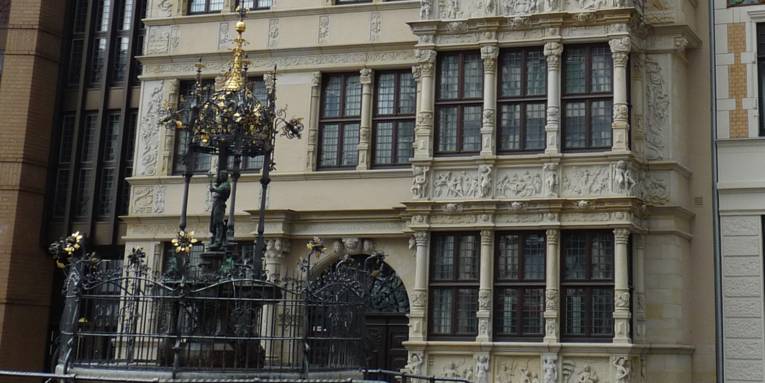The house of Leibniz is named after the most significant philosopher of the baroque and polymath Gottfried Wilhelm Leibniz, who lived and worked on the first floor of the building from 29 September 1698 until his death on 14 November 1716. A lot is not known about the interior of the facilities. The historic seminar at the Leibniz University Hannover reveals in a brochure called "Leibniz and Hannover - On the Scent of the Renaissance Man" that Leibniz even had an own cupboard for his numerous notepads.
The brochure also gives more insights into the further whereabouts of the court library (this one was already part of the house before Leibniz moved in) as well as the history of the house of Leibniz: "In 1719, the royal library moved to the newly built archive building at today's Waterlooplatz. After Leibniz had died, no one paid attention to his (last) residence any more. This changed during the first half of the 19th century. In 1840, his house was annotated as a speciality on the city map of Hannover. King Ernst August from Hannover, who took a stand for the house with the historically charged past, bought it for 27,000 Reichstaler in gold in 1844 and got the front cleaned. A board was applied, identifying the house as the (last) residence of Gottfried Wilhelm Leibniz. In 1866, it was appointed property of the Prussian state, in 1893 finally as a Museum of the Arts and Craft Society. The room was adapted to his living room and death chamber with some furniture and historical objects."
Originally built in 1499, the four-storeyed patrician house with the high gable and decorative front from the renaissance was located in Schmiedestraße 10. In the night of 8 to 9 October 1943, aerial bombs destroyed the house though during an airstrike of the British Royal Air Force in Hannover.
Specific considerations about the reconstruction of one of the oldest and most beautiful bourgeois houses of the city of Hannover only emerged in the course of the 1st International Leibniz Congress in 1966, hosted by the Gottfried Wilhelm Leibniz Society in the same year. As the original location in Schmiedestraße 10 was not available anymore, an adequate replacement had to be found. Construction works finally began in 1981 in the nearby old town at the Holzmarkt next to the Historical Museum. Based on original plans, the rebuilt new building was completed in 1983 with a renaissance front recreated true to original. The building was officially opened with a big cerimonial act.
In his day, Leibniz already knew: "We desire nice things because they are enjoyable. I define beauty as something that is pleasant to look at." Surely this also applies for his newly built residence at Holzmarkt 5 in the old town which nowadays ranks among the most popular motives of Hannover. The house of Leibniz is used as a guest house and event venue these days by different universities in Hannover. A tour of the small Leibniz exhibition and the different facilities is also available on request.
Another photogenic monument is the lavishly ornated Oscar Winter fountain in front of the house of Leibniz. The people of Hannover just call it "wishing well": The wrought-iron bars around the mighty fountain basin contain a big ring that supposedly makes wishes come true if you just turn it.
 Deutsch
Deutsch
 English
English
 中文
中文
 Danish
Danish
 Eesti
Eesti
 Español
Español
 Suomi
Suomi
 Français
Français
 Italiano
Italiano
 日本語
日本語
 한국
한국
 Nederlands
Nederlands
 Norge
Norge
 Polski
Polski
 Portugues
Portugues
 Русский
Русский
 Svenska
Svenska
 Türkçe
Türkçe
 العربية
العربية
 Romanesc
Romanesc
 български
български
 © hannover.de
© hannover.de